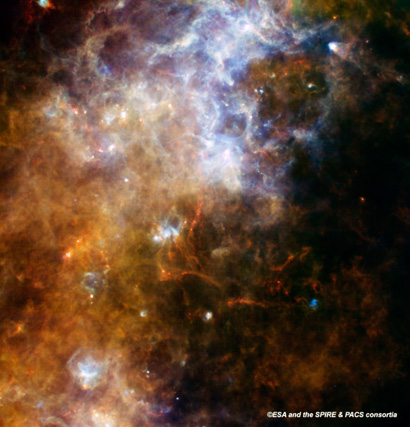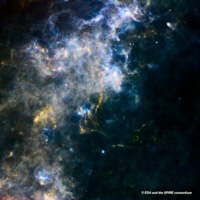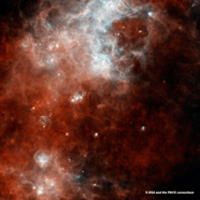New Herschel images reveal previously unseen detail in the Milky Way
2 October 2009
Images from the Herschel observatory, obtained during the performance verification phase, reveal previously unseen detail in a region of the Milky Way near the Galactic Plane. These images demonstrate that the 'SPIRE/PACS parallel mode', an important observing mode for the observatory, is delivering the expected performance.
 |
|
SPIRE/PACS image of region near the Galactic Plane. |
In early September, during the Herschel performance verification phase, the SPIRE and PACS photometers were used in 'parallel mode' to observe a 2 x 2 degree field in an area near the Galactic Plane, 60 degrees from the Galactic Centre, in the constellation of the Southern Cross. This region is considered to be a good test case for verification and demonstration purposes as it is typical of crowded fields where there may be many molecular clouds along the line-of-sight. Studying the earliest phases of star formation in molecular clouds is an area of scientific investigation to which Herschel is particularly well-suited, and the ability of the SPIRE and PACS instruments to map regions of massive cloud complexes provides the capability to detect stages of star formation which have not been found with previous infrared missions.
 |
 |
|
SPIRE (left) and PACS (right) parallel mode images obtained during the performance verification phase. | |
The resulting images reveal an extremely rich reservoir of cold material in the Galactic Plane that is seen to be in a previously unsuspected state of turmoil. Interstellar material appears to be condensing in a continuous and interconnected maze of filaments and strings of newly-forming stars in all stages of development. The observations yield additional information about this cold material - such as how much there is, its mass, temperature and composition, and whether or not some of it is collapsing to form new stars. Observations like these will be key to addressing the primary science goals of Herschel: the study of star formation and the interstellar medium in the Milky Way and nearby galaxies, and the detection and investigation of galaxies in the distant Universe.
Observing with the 'parallel mode'Herschel is a versatile space observatory with a wide range of capabilities covering point-source photometry, imaging, large area mapping and spectroscopy. The observatory offers a number of different observing modes which have been devised to optimise the scientific return of the mission. The 'SPIRE/PACS parallel mode' is one of Herschel's most powerful and effective observing modes. Here the SPIRE and PACS cameras observe simultaneously while the telescope scans across the sky. Using both instruments together this way produces five images simultaneously in different wavelengths, making the best possible use of the superfluid helium cryogen that ultimately defines the lifetime of the Herschel mission. Since the fields-of-view of the two instruments are almost 20 arcmin offset from each other on the sky, this mode is particularly useful for imaging large areas in survey-type observing programmes.
A number of Herschel’s large scientific projects, or Key Programmes, will be carried out using the parallel mode. Large areas of the Milky Way will be surveyed systematically, exploring astronomical 'terra incognita' and providing new insight into the mechanisms at play during star formation. The parallel mode will also be used for observations of 'blank fields' – this has applications in extragalactic astronomy, with particular relevance to understanding the history of star formation throughout cosmic history.
Contact
Göran Pilbratt, Herschel Project ScientistResearch and Scientific Support Department
Science and Robotic Exploration Directorate, ESA, The Netherlands.
Email: gpilbratt
 rssd.esa.int
rssd.esa.intPhone: +31-71-565-3621


